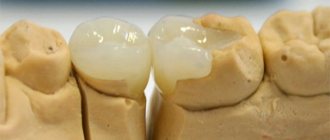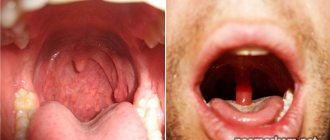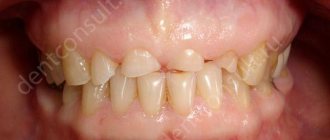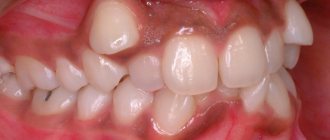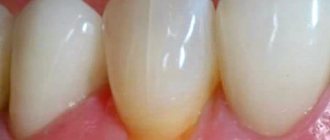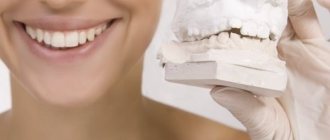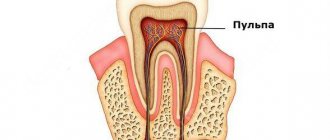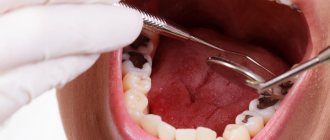Why re-treat canals?
Endodontic dental treatment is not always carried out in line with modern trends and requirements. According to statistics, complications in the form of chronic inflammation occur in 60-70% of patients. Treatment of dental canals is a painstaking work that must be performed by an experienced doctor using modern high-precision equipment and functional tools.
The following shortcomings of the previous intervention may serve as a reason for revising the channels:
- the presence of unfilled areas (voids). The reason is incorrect measurement of the channel length and insufficient machining;
- poor-quality filling materials, due to poor fit of which the canals become depressurized and infection opens;
- fragments of pins and instruments stuck in cavities;
- passage of additional channels and closing them along with the remains of the pulp (creation of an infectious “depot”). Molars usually have three canals, but there are specimens with four or five - they are the ones that remain “unaccounted for”;
- insufficient expansion and poor-quality cleaning of canals, formation of “steps” and root perforations due to deviation of the instrument from the anatomical shape of the course. The result is an under-processed apical part of the root (the apex of the root in dentistry means its lowest point).
As a result, the infection from the canal enters the gum tissue, and foci of chronic inflammation develop at the root tips - apical granulomas and radicular cysts. Such formations were previously considered an absolute indication for tooth extraction (cystectomy).
Endodontic treatment of tooth canals using optics
Such verdicts were completely justified, since a progressive cyst can lead to gum deformation, destruction of bone tissue (osteomyelitis), periodic inflammation and suppuration. Some dentists still consider removing a tooth with problematic roots to be the only rational option.
The IMEZA clinic has the personnel and technological capabilities for complete sanitation of cystic formations while preserving the dental unit. Our specialists have experience treating patients who were previously scheduled for tooth extraction due to the presence of foci of chronic inflammation. But there are cases when cystectomy is really the only option - destruction of more than 2/3 of the root or the impossibility of restoring the functionality of the dental unit.
Timely retreatment of questionable canals will help avoid complications and tooth loss. Our doctors objectively assess the risks and feasibility of manipulation for each individual patient, taking into account the degree of destruction of the crown and roots, the functional load on the tooth, and the possibility of subsequent restoration.
Endodontic treatment of teeth - an opportunity to save a tooth
If you are recommended to have a tooth removed, do not rush. Perhaps he can still be saved. For this purpose there is retreatment of teeth. However, this procedure requires an experienced specialist and the availability of modern equipment in the clinic, for example, an operating microscope.
When may tooth canal retreatment be necessary?
- Before prosthetics.
- Inflammation of the dental nerve.
- Canals that are not completely sealed.
- Apical periodontitis is an infection of the apex of the tooth root.
- Poor quality primary treatment.
Typically, a patient presents with pain in a previously treated tooth. On an x-ray, you can often see a hidden focus of inflammation, fragments of a dental instrument, or an infection that has spread to the tooth tissue
Therefore, pain in a filled tooth requires mandatory consultation with a doctor for consultation and treatment.
What happens if the tooth is not treated on time?
- A recurrence of caries will occur, but with much greater complications.
- When filling a tooth, mistakes can be made that lead to the formation of a cyst: bacteria enter the tooth and purulent formations occur.
- A nerve that is not completely removed can become inflamed.
All this leads to severe pain and can result in tooth extraction. To avoid this, dentists recommend using a modern procedure - repeated endodontic treatment of the tooth.
X-ray or microscope
The recommendation for the use of this rather complex method of dental treatment is an x-ray. It allows you to identify foreign bodies, inflammatory processes and partial filling of the canals.
Even more accurate information is provided by the use of a microscope. This is a more modern approach to dentistry that helps the dentist see the full diagnostic picture. Under a microscope, an endodontist can detect fluid in the canal, those nerve tissues that are not completely healed, and magnification will not allow the canals to be missed.
The use of a microscope makes it possible to treat a tooth more efficiently and avoid serious diseases or poor-quality canal treatment.
Advantages of a microscope , which helps the endodontist preserve even severely damaged teeth:
- Minimizes the risk of re-infection.
- Magnification makes it possible to accurately determine the number of channels.
- Lighting and multiple magnification improve the quality of root canal treatment.
Signs of canal infection
In some cases, patients can independently determine the presence of problems with a previously treated tooth. The main signs of canal infection are:
- pain that did not go away after treatment or occurred some time after it;
- a feeling of fullness in the gums, discomfort when pressing on the tooth;
- the presence of swelling, swelling on the gums, as well as the formation of a fistulous tract (cyst breakthrough);
- changing the shade of the dental crown from light to gray. This may indicate dentin destruction;
- persistent unpleasant odor.
If you have the above symptoms, you should not waste time by self-medicating. At the IMEZA clinic, the patient can count on a quick, accurate diagnosis and adequate treatment.
Obturation
Retreatment of the canals is completed by filling them, or obturation.
This is interesting: Icon (Icon) - treatment of caries using the infiltration method
Retreatment of the canals ends with their filling, or obturation . For this purpose, various filling compounds are used, which may include antiseptics and pins. The doctor’s task at this stage is to completely fill the root canal with filling material along its entire length, which will prevent the development of the inflammatory process in the future.
The patient should definitely remember that root canal retreatment allows you to save “your” tooth , while constantly postponing a visit to the dentist can lead to its loss.
Our clinic employs specialists who have academic degrees and extensive experience in dentistry. They will perform root canal retreatment effectively, competently, and quickly.
This type of treatment is quite complex, so you should trust only good specialists .
Stages of canal retreatment
The procedure for re-treating the canals begins with providing access to them: removing the crown or removing (drilling out) the old filling, removing the stump inlays and pins. Then the canal cavities are freed from the filling material.
One of the stages that determines the quality of endodontic treatment is the correct measurement of the working depth of each canal. The most accurate result is obtained when using an apex locator - an electronic device connected via an electrode to a radiopaque K-file (a thin instrument immersed in the canal). As the K-file approaches the lowest point of the canal (apical constriction), the apex locator signal intensifies. An x-ray helps to clarify the readings of the device.
To ensure proper filling of the canal and adhesion (adhesion) of the filling material to its walls, preliminary mechanical treatment is necessary. Cleaning is done with hand instruments (high risk of breakage) or using an endodontic tip into which nickel-titanium profiles (thin drills) are inserted.
The intensity of rotation of the profiles is controlled by a micromotor, which triggers a reverse if the permissible pressure is exceeded. This method guarantees the absence of perforations, nicks and eliminates breakage of the instrument in the canal. Ultrasonic scalers and dentin softeners are used as auxiliary measures. This promotes maximum preservation of healthy tissue.
An important component of the canal revision process is their sterilization. The cavity is thoroughly washed and disinfected with antiseptics. In the presence of inflammatory formations, the following measures can be taken:
- opening the gums and excision of the root apex or complete removal of one of the roots (hemisection);
- laser removal of infected tissue;
- sanitation of channels through electrophoresis with calcium and copper ions.
After sterilization, filling material is placed. If the working length is incorrectly determined during machining, the top of the channel opens and the material flows beyond its limits. As a result, the patient will be bothered by prolonged pain, inflammation and neuralgia. At the IMEZA clinic, such errors in treatment are excluded.
The retreatment procedure is associated with additional damage to the coronal part, therefore, in some cases, its position is strengthened using an intracanal pin. Manipulation is possible if the layer of dentin surrounding the pin is at least 2 mm. Installation includes the following steps:
- preparing the bed using a calibration tool;
- adjusting the length of the pin;
- etching and drying the bed;
- applying adhesive material directly to the pin or into the cavity of the bed;
- installation of the rod, polymerization of the adhesive mass.
After completing the canal filling work, the dental cavity is closed with a temporary filling. At the next visit, the doctor begins to restore the upper part of the tooth using an artificial crown, inlays or volumetric restoration techniques.
After treatment, discomfort when biting on a tooth may persist for 3-5 days. If there are no complications, you should return for a routine examination in a year.
Indications and contraindications
There are a number of indications for re-treatment of problematic units. They can be a consequence of errors made during the first treatment, as well as objective factors that could not be foreseen.
The following dental mistakes can lead to the need for retreatment.
- Poor quality cleaning and disinfection of canals , leading to the persistence of a source of infection in them.
- Incomplete filling of the cavity with a filling . The emptiness in the canal promotes the proliferation of pathogenic bacteria and the occurrence of an inflammatory process.
- Poor quality placement of the filling , leading to a violation of the tightness of the sealed canal. Depressurization is one of the main reasons for the penetration of bacteria into the cavity and the development of re-infection.
- The use of low-quality filling materials (cement, composites, adhesives, etc.), which do not ensure reliable marginal adherence of the filling to the coronal part of the element.
- Leaving foreign objects in the cavity - pieces of dental instruments, particles of intracanal pins, etc.
Retreatment may also be required for objective reasons independent of the quality of treatment. In particular, infection can enter the canal due to trauma to the oral cavity or from neighboring infected units. Corrosion of the metal pin is possible, leading to the destruction of adjacent tissues.
Typically, canal revision does not encounter insurmountable obstacles, but there are cases in which retreatment is impossible or impractical.
They can be divided into 3 groups:
- Absolute contraindications are cases when the problem unit is in such an unsatisfactory condition that its functions can no longer be restored.
This, in particular, is the destruction of the periodontium in an area of at least 2/3 of the root length, or the general serious condition of the patient, making therapeutic intervention impossible. - Contraindications caused by lack of access to the diseased element due to the special condition of the oral cavity. For example, the inability to open the mouth or the patient’s categorical refusal of treatment.
- Temporary contraindications due to the need to postpone treatment for some reason, for example, a disease of the oral mucosa.
In each specific case, the decision to re-treat or refuse it is made by the doctor, taking into account the priority of preserving the unit.
This is interesting: Why cracks appear in the middle of the tongue in adults - a list of the most common reasons
Microscope or X-ray
Currently, dentistry uses two types of control over the treatment process: x-ray and using a microscope. X-ray is inferior both in terms of diagnostic capabilities and from a safety point of view:
- Some types of pins and composite materials are not visible in the photographs, which blurs the objective picture of the condition of the dental canals;
- optical distortions and channel overlap are possible;
- if there is liquid in the cavity, then the x-ray will not show it;
- To diagnose and monitor the treatment of the canals, a series of images will be required, and this, although insignificant, is still radiation.
A dental microscope is capable of magnifying the image 30 times - the doctor will notice the smallest tissue defects. You can easily detect the mouths of additional canals, examine their most tortuous configurations, assess root damage and monitor the quality of cleaning.
The microscope allows for unsealing with ultrasound, thereby preserving a large volume of valuable healthy tissue. Optics has significantly expanded the possibilities of dentistry in terms of restoring teeth that were previously considered hopeless. Treatment under microscope control almost completely eliminates the development of recurrent inflammatory processes and ensures long-lasting results.
Patients of the IMEZA clinic can count on high-quality canal retreatment using high-precision optical equipment, technological instruments and modern materials. It is enough to make an appointment, during which experienced doctors will identify all potentially dangerous elements and determine the optimal therapeutic tactics.
Why is root canal retreatment sometimes necessary?
Unsealing, re-treatment and filling of root canals is a dental procedure that is significantly more complicated than primary treatment.
Many patients believe that re-treatment of tooth canals is necessary for only one reason: poor-quality primary treatment .
Yes, unfortunately, this factor occurs in some clinics. But there are often quite objective reasons:
- The infection re-enters the apex of the tooth root from the periodontium;
- During the initial treatment, the doctor, for objective reasons, could not identify and eliminate part of the pathological focus in the root apex;
- Different patients may have different types of root canals, which also sometimes leads to difficulties during treatment;
- After filling the canals, the hermeticity of the filling or inlay plays a very important role: if the tooth is not restored hermetically, then putrefactive microbes penetrate into the periodontium even through a well-sealed canal .
